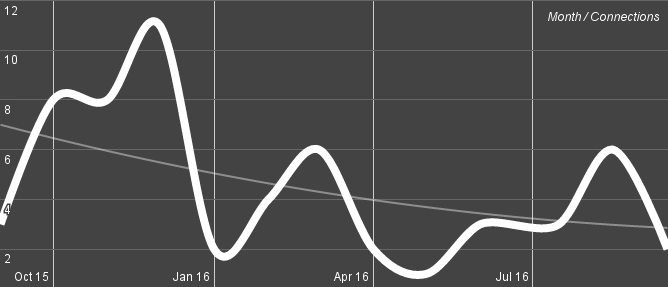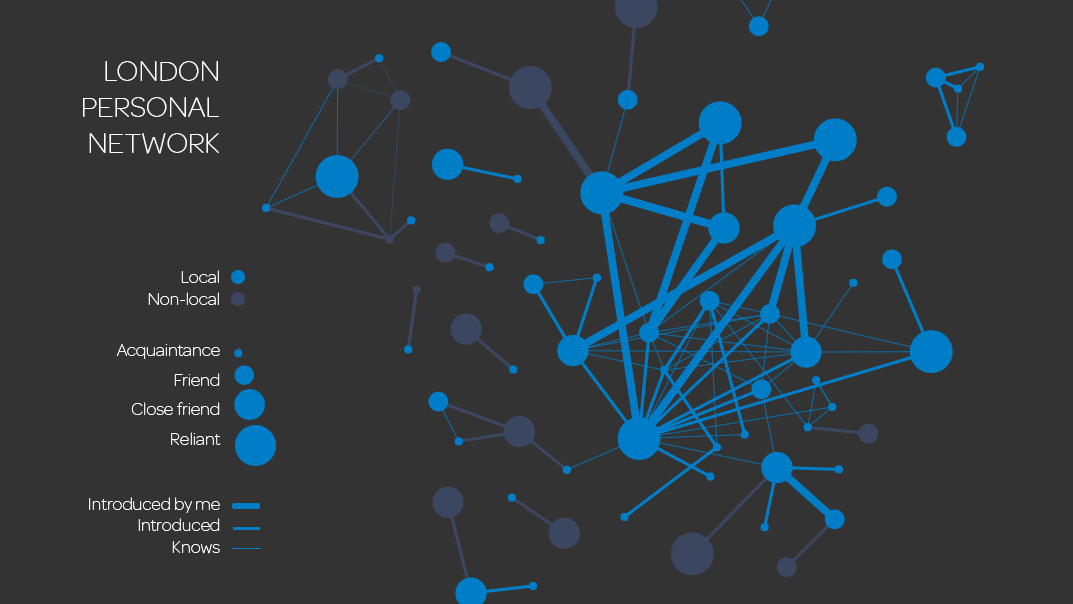Can hardly believe it has been over a year since I moved to London! As an anniversary present, London gifted me my first truly serendipitous connection since my arrival. Until then, every new connection was the result of either a direct introduction or meeting at an event that both people intentionally attended. It’s a rare treat to meet anyone during those in between states; by accident, in public places, on transit. I treasure those moments because they often expose a ‘small world’ coincidence or a completely new, fascinating world.
Additionally, I had the chance to participate in Wait But Why’s inaugural Wait But Hi event in August. Our group was even featured in their report (scroll down about 1/5th to “Some people went to restaurants…”). They asked their readers to fill out a (long) survey and then matched them in groups based on their interests and preferences. Some people were set up on individual blind dates while others participated in large group educational seminars (and many variations between). What a fascinating experiment in friendship, relationship and community building!
Round up. Here are some of the more interesting articles and reports related to friendship that have popped up over the last 3 months. First and second round-ups here and here.
- Ease of Settling In Index: Finding Friends from InterNations
- Reclaiming Friendship: A Visual Taxonomy of Platonic Relationships to Counter the Commodification of the Word “Friend” from Brain Pickings
- Do your friends actually like you? from The NY Times
- The companions of my heart: On making friends on the internet from Slate
- Platonic dating apps by J. Walter Thompson Intelligence
It’s official, I have completed a full year of The Reliants Project and have learned an incredible amount along the way – not to mention all the wonderful new friends I have made! Above is a new visual I created with Polinode using my connection-tracking spreadsheet. This only shows connections that were directly introduced to me or have a mutual connection within my personal network. It also doesn’t have any indication of time.
Below I share the final manually-created visual, summarise the statistics, share learnings and propose questions based on what I’ve gathered from actively tracking the growth of my personal network. If you’re looking for my previous posts over the course of the past year+, you can find them here: background, introduction, 3 months, 6 months, 9 months.
A quick reminder: the diagram doesn’t keep track of frequency of interactions and I don’t include new connections if there’s no real initiative to maintain contact. I’ve only included co-workers with whom I’ve built a friendship outside of work. I haven’t included anyone I’ve met who does not currently live in London.
Stats. My London personal network has grown about 4x over the last year. That ~90 person network breaks down as follows (again, based on how social networks are often categorised).
- 50 acquaintances (ie. see them socially)
- 20 friends (ie. would invite to a group dinner)
- 10 close friends (ie. often hang out 1-on-1)
- 7 reliants (ie. would ask to help move flats)
Of the reliants, 4 were pre-existing connections, 2 of which grew from friend to reliant in part due to living in the same city. One of the new reliants was directly introduced to me and I met the other 2 on my own at niche events. Among the close friends, half were directly introduced and the other half I met at events. Friends are disproportionately from my pre-existing network base, but that’s probably because they ‘stood the test of time’ (and distance). I met most connections labeled ‘acquaintances’ at private events, which makes sense because they are part of the same social circle but I haven’t built a meaningful relationship with them individually.
In order to grow that network, I attended about 25 public events (activity-based events, conferences, Meetups, etc.) and about 40 private events (where more than 3 people participated and I didn’t know everyone). I also met with 30 people that were directly introduced to me. Those introductions came from about 65% non-locals contacts, 30% from new local connections and just 5% from pre-existing connections. The graph below shows how many people I met per month over that time.

Learnings.
Existing networks don’t directly translate to new connections. Even after a year in London, I have only received a handful of direct introductions from my pre-existing local network. There are still several pre-existing connections that I haven’t even managed to meet with myself! Non-local and new connections were significantly more likely to introduce me to people in their network, as were pre-existing connections that moved to London after me.
‘Super connectors’ increase the number of people you meet, but don’t necessarily result in stronger connections. There are probably 4 people in my network that I would label super connectors. They have each invited me to 3 events where there were at least 15 people in attendance. Only one of the connections I made at these events now falls into my close friend category, but they make up the bulk of my acquaintances.
There seems to be an inverse relationship between size of event and connections made. Conferences, large parties and other groups with more than 15 people seem to make meaningful connections hard to come by. Direct introductions and small gatherings seem much more effective environments for building friendships, particularly if they are hosted by super connectors.
“Weak ties” are strong when building personal networks in new places. If I trace back the 17 reliant and close friend connections I’ve built over the last year, at least 7 have a weak tie at some point in the chain. These connections seem to rely on the social capital of the person making the introduction, where the parties on the receiving end trust that their interests have been kept in mind.
The rhythm of making connections is cyclical. There seems to be a natural balance between building connections and maintaining them. While I focused my time over the first 3 months making new connections, I quickly fell into a pattern of strengthening those connections rather than continuously seeking new ones. Typical holidays, vacations and work schedules also had an impact on the frequency of events where I could meet new people.
Categorising relationships is incredibly difficult and changes over time. While I didn’t actively track the progression of connections from acquaintance to friend to close friend to reliant, a few familiar patterns emerged. The analogy that comes to mind is that of a staircase, where certain catalysts would propel the relationship to a higher step. Most commonly, neither person was motivated to maintain a connection, so we didn’t even become acquaintances. Sometimes there was mutual desire to strengthen the connection, but after several failed attempts to reconnect, the relationship never made it past the acquaintance stage. If the connection managed to avoid those pitfalls, it often developed into a friendship. Significant life events have the potential to be both a positive and negative catalyst, best at bringing people closer together through shared experiences or need for support.
If you’re moving to a new place…
- If possible, ask your friends (wherever they live) to make direct introductions to people they know in your new place.
- Attend public Meetups or other events on topics that are of particular interest to you (the more niche, the better).
- Seek out individuals that are natural networkers and hosts (then attend their events and seek new connections through them).
- Make time for new connections to strengthen by meeting one-on-one and introducing them to your own network.
What’s next? Right now I’m interested in building a more complex visual of my entire personal network using D3 or Polinode in the hopes that it will give me a more accurate representation of my network than Facebook, LinkedIn or Twitter. I’m also interested in tackling the following questions:
- How does intention, emotional intelligence and vulnerability impact making connections?
- Does life stage or the potential for value exchange play a role in which connections are actively nurtured?
- How do contextual details (e.g. day of week, time, location, structure, event size) impact the effectiveness of making new connections?
- Can you visualise how new connections transition between acquaintance, friend, close friend and reliant categories over time?
- Are ‘super connectors’ more likely to have higher measures of betweenness or centrality within their own personal networks?
- How important is it for relationships within networks to have multiplexity or symmetry to be resilient?
- How does an individual’s position within their network change as a result of significant life events (e.g. career shifts, relocation, marriage, childbearing, divorce)?
Thanks to everyone for following along!


Pingback: Change over time | with ease
Pingback: Primary relationships impact personal network structures | with ease